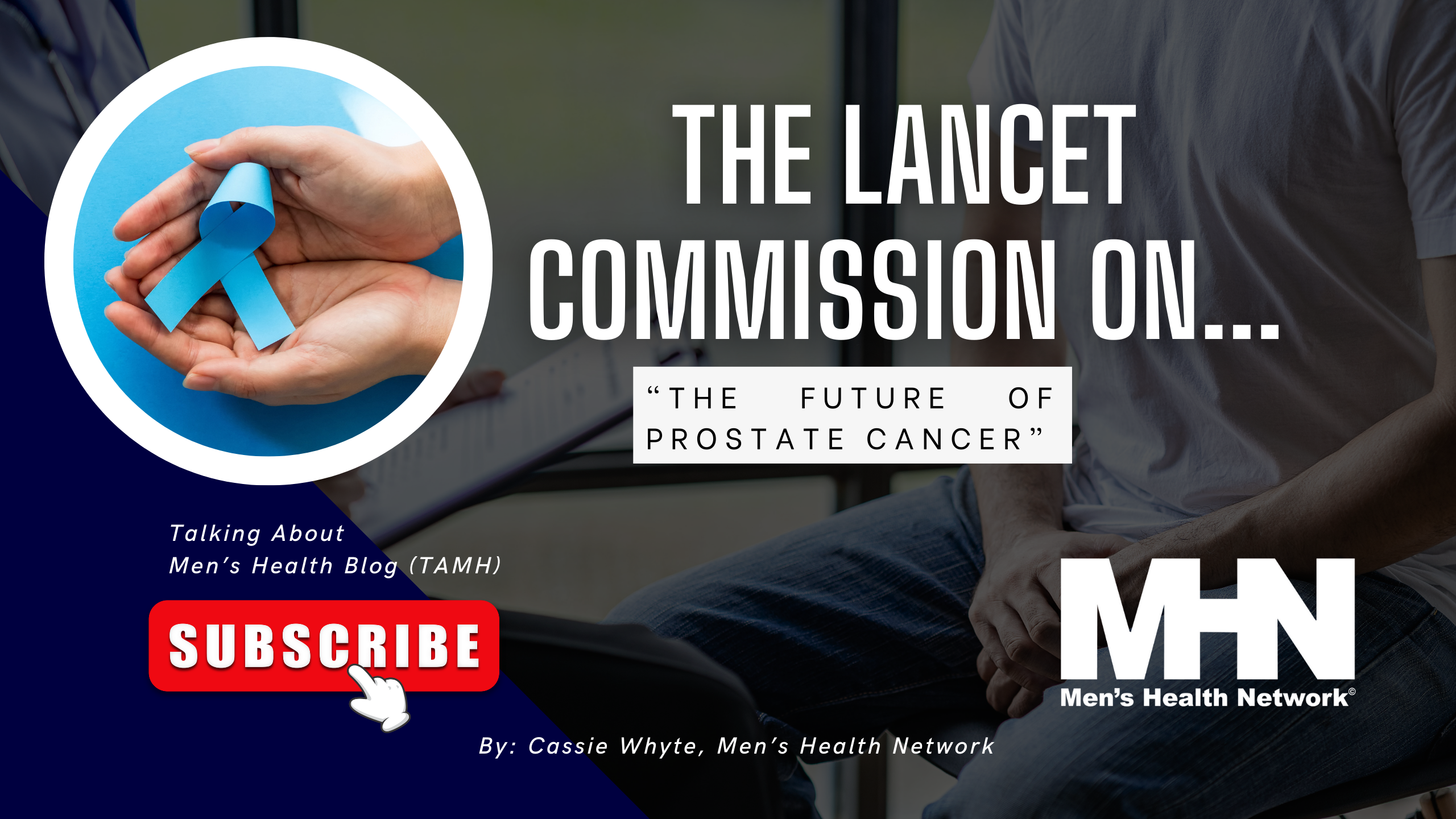The Lancet Commission on The Future of Prostate Cancer
The Lancet Commission is an independent medical journal that, since its inception in 1823, has sought to disseminate scientific information and analysis on a broader scale in the pursuit of a healthier international community.
At the beginning of April, 2024, the commission produced and published a comprehensive, strategic exploration on the global state of prostate cancer in the coming decades.
Interestingly, the commission takes a holistic approach to prostate cancer diagnosis, treatment, and education, asserting that, “as the rise in prostate cancer is likely to be mirrored by rises in other conditions such as diabetes and heart disease, early diagnosis programmes should focus not just on prostate cancer but on men’s health more broadly” (James et al., 2024, p. 1).
The commission recognizes both the pervasiveness and severity of prostate cancer on a global scale, projecting that, “the number of new cases will double between 2020-2040,” a troubling conclusion that we in the men’s health sphere recognize as being indicative of a larger issue: a general disregard for understanding men’s health, as well as the necessity to view prostate cancer through a gendered, recontextualized framework (James et al., 2024, p. 8).
The commission also grounds their analysis and prescriptions by incorporating elements of variation across countries in accordance with economic concerns, the at times ineffectual practices of pharmaceutical companies, and prominent racial disparities that have been historically unaccounted for in clinical settings.

The Lancet Commission acknowledges the unique conditions and clinical pathways observed in HIC’s (high-income countries) and how implementation of diagnostic tools and treatment differ profoundly in LMIC’s (low or middle income countries).
The article states, “in HICs, for non-metastatic disease, the emphasis should be on reducing overtreatment in low-risk disease and reducing the treatment burden in higher-risk disease,” by outlining methods such as active surveillance, watchful waiting, informed choice-based testing, expansion of access, and “empowerment of patients,” via targeted circulation of educational materials and medical literature (James et al., 2024, p. 19).
However, the global proliferation of prostate cancer cases, “are set to increase substantially in LMICs with little or no increase in most HICs,” so much of the necessary resources, policy recommendations, and education campaigns should focus primarily on these low and middle income countries (James et al., 2024, p. 15).
According to the commission’s findings:
“in LMICs, too many men present with advanced disease—a major societal problem causing suffering, early death, and financial hardship for families” (James et al., 2024, p. 13).
But to what extent, and through what means, can this suffering be mitigated? Prostate cancer, as is the case with many forms of cancer, cannot exactly be prevented. The commission recognizes this unfortunate reality, opting to articulate the essential role that early diagnosis plays in harm reduction. And one of the best ways to facilitate a collective pattern of early diagnosis is by conducting outreach via educational campaigns, increasing active patient engagement, and promoting general public awareness.
Many LMIC’s, for example, have a proclivity toward medical hesitancy and a bias for alternative, less effectual treatments:
“studies of public awareness of prostate cancer in a range of countries in Sub Saharan Africa suggest widespread misconceptions about prostate cancer symptoms and treatment, coupled with reliance on traditional healers and taboos around discussing diagnoses” (James et al., 2024, p. 29).
This proliferation of disinformation, however, is not particular to LMIC’s.
The commission also expresses concern regarding “false or inaccurate information” that also “circulates in HICs, including on YouTube” and other social channels (James et al., 2024, p. 29).
The amplification of such disinformation and related sentiments of anti-intellectualism and medical distrust could forebode the potential for a backsliding quality in prostate cancer diagnostics and treatment, even in HIC’s where access to quality care is more broadly available. Moreover, growing medical distrust, though misguided, is not completely baseless or even unjustified.
The Lancet Commission cites a WHO report stating, “pharmaceutical companies set prices according to their commercial goals, with a focus on extracting the maximum amount that a buyer is willing to pay for a medicine” (James et al., 2024, p. 20). The result of these practices, naturally, is ubiquitous unaffordability of cancer drugs and treatment. Additionally, the commission proclaims, “the biggest potential gains for both patients and governments are related to achieving early diagnosis—an area of little pharmaceutical interest” (James et al., 2024, p. 33).
Therefore, despite the commission’s goal of prioritizing early detection, particularly in LMIC’s, conflicting interests within the pharmaceutical industry may prove to be a significant barrier in achieving its delineated aims.
Much of the medical misinformation propagated via social media is both produced by and targeted at men.
For instance, “multiple studies have demonstrated a large volume of low-quality urologic information relating to prostate cancer and other disease processes across SoMe platforms such as YouTube, Facebook, and Twitter” (Dubin et al., 2022, p. 1).
But what conclusions should we derive from these findings? Are men simply more inherently inclined to consume fallacious health content? Or are these inexpert, misinformed beliefs merely filling a vacuum created by the lack of outreach, engagement, and awareness initiatives regarding men’s health topics?
We at Men’s Health Network would wager it is overwhelmingly a consequence of the latter.
And furthermore, we would presume that a popularization of discourse and a particular emphasis on men’s health as a specific, distinctive domain could be a powerful force in combating medical misinformation.
The lifespan gender-gap is a reality that we, as men’s health advocates, healthcare providers, and patients alike, desperately need to address.
The disparity in life expectancy between U.S men and women is now at its most substantial since the mid 1990s; it is estimated that women live approximately 6 years longer than men on average.
While some projections profess that this disparity will begin to decrease globally, the lifespan gap has persisted for decades in almost every country. The life expectancy gap between men and women is often attributed to men’s tendency to neglect their physical and mental well-being, as well as their higher participation in risk-associated behaviors such as smoking.
There is certainly some truth to this explanation, but there is also a glaring disparity in both popular discourse and policy solutions regarding women’s and men’s health. For instance, despite our strenuous efforts at MHN, there is still not a single department of men’s health within the robust bureaucratic infrastructure that is the American federal government.
Much of this indifference to men’s health is downstream of the assumption that there is no need for it.
Men’s health has, of course, historically been treated as the default in clinical settings, and was fairly considered to be incorporated under the general umbrella of health. But this is no longer, at least on a broad scale, the case. Subsequently, men’s health needs to be addressed and engaged with as its own particular domain.
However, this suggestion is often met with confusion or even disdain, as it is common in public opinion to consider men as a privileged class not warranting any special or isolated attention. But while men are still a relatively privileged class in a plurality of spheres, such as the financial and political, health, physical and mental, is not clearly one of those arenas.
It is also essential to address a common attitude that often infiltrates health-oriented discourse:
That of the zero-sum game persuasion.
Allow me to clarify this assumption…

When the concept of men’s health is put forward in discussion, many people hear this suggestion as an attack on women’s health. This reactive response presumes an underlying opposition between the health and well-being of women and that of men, but this is not whatsoever, in actuality, the case.
Men’s health and women’s health are not competing interests, and should not be thought of as such. In fact, they are compatible projects, not mutually exclusive entities, that can be pursued harmoniously and with substantial collaboration. Projects such as The Lancet Commission on prostate cancer that articulate a vision for global men’s health in relation to prostate cancer should not be thought of as being conducted at the expense of women’s well-being, but as a supplementary companion to it.
In order to popularize and publicize this model of men’s health, as was discussed previously, outreach designed particularly for men needs to be conducted on a global scale.
According to the Lancet Commission’s article, “the rapidly changing landscape of modern communications technology offers huge opportunities to connect to people and to educate about prostate cancer” (James et al., 2024, p. 26).
Social media can, in this manner, be utilized as a benevolent instrument of dissemination and education, specifically where access to information is otherwise limited:
“even people living in remote places often still have access to mobile telecommunications. Social media channels like TikTok, Instagram, and X have huge reach” (James et al., 2024, p.30).
The Lancet Commission’s findings vindicate the urgency and potency of awareness campaigns, and this trend is likely exacerbated with regards to health conditions disproportionately affecting men. The need for proactive, intentional outreach is heightened by the factor of gender, as health-oriented disinformation appears more likely to fester and promulgate in male-dominated spaces, both in person and online.
Moreover, the Lancet Commission highlights a systematic review “that included six prostate cancer-specific studies [that] identified low health literacy as a major barrier to early cancer diagnosis in LMICs, alongside the stigma of a cancer diagnosis and restricted access to primary care, particularly in rural areas” indicating an additional obligation to prioritize low and middle income countries while conducting health awareness initiatives (James et al., 2024, p. 26).
Ultimately, prostate cancer poses a significant threat to men’s well-being on a global scale, and this is especially the case in lower income countries that lack the clinical infrastructure to administer early detection strategies.
The commission illustrates the importance diagnostic and treatment pathways carry regarding health outcomes:
“globally, more equitable health care systems have been estimated to potentially save 8 million lives annually, with large societal and economic benefits,” advising stakeholders to promote a framework of health literacy: “access to reliable, balanced, and up-to-date health information both at the personal and systems levels is key to effecting improvements in care and to support patients and their families in clinical decision making” (James et al., 2024, p. 31; p. 26).
Novel approaches, as well as approaches deliberately geared toward men, should be actively piloted: “evidence suggests that celebrities addressing their health concerns, and information provision in male community hubs such as barbershops can help to effectively spread awareness” (James et al., 2024, p. 29).
Perhaps the most fundamental conclusion we can draw from the commission’s findings is that advancements and improvements to prostate cancer care can not only be tangibly, realistically accomplished, but more than this, that positive, productive transformations in health outcomes will be the inevitable result.
As for what the increasing attention to prostate cancer morbidity and mortality means for men’s health more broadly, respected journals and organizations such as the Lancet Commission proposing a perspective on men’s health as a particular, comprehensive domain is certainly a good sign.
Hopefully, we will start to see more stakeholders start to imitate this language, and help advance an “agenda for a realistic programme of changes, which, if implemented, will improve the health of men globally both now and in future” (James et al., 2024, p. 2).
References
Dubin, J.M., Aguiar, J.A., Lin, J.S. et al. The broad reach and inaccuracy of men’s health information on social media: analysis of TikTok and Instagram. Int J Impot Res (2022). https://doi.org/10.1038/s41443-022-00645-6
James, N.D., Tannock, I., N’Dow, J., et al. The Lancet Commission on prostate cancer: planning for the surge in cases. The Lancet Commission (2024). https://www.thelancet.com/journals/lancet/article/PIIS0140-6736(24)00651-2/fulltext#seccestitle10





[…] Supply hyperlink […]
[…] Disclaimer: This story is auto-aggregated by a computer program and has not been created or edited by menshealthfits.Publisher: Source link […]
[…] #Lancet #Fee #Future #Prostate #Most cancers #Speaking #Mens #Well being Supply hyperlink […]
[…] Source link […]